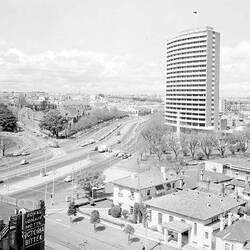In 1854 the activities of the Diocesan Grammar School at Eastern Hill were suspended. Community members felt the need to replace it with another Church of England school, particularly since a secular education system did not yet exist. The colonial government granted 15 acres in St Kilda Road. The School moved into new bluestone classrooms on the site in 1858, with just 77 pupils. In 1886 Wadhurst was established as a Preparatory School.
The School's first 40 years were a struggle. Changes in headmasters and the 1890s economic depression saw Senior School enrolments fall from 272 in 1889 to 117 in 1894. The Old Melburnians Society was hastily formed in April 1895 'to be the means of bringing together many former schoolmates, reviving pleasant recollections, and at the same time benefiting the life of the School as it is today.' The organisation continues to this day.
In 1892-93 the first purpose-built school chapel in Victoria was constructed at the school. It was designed by AE Johnson in the modern British tradition of Pearson and Burges.
In the new century stability was established and enrolments increased. The accustomed division of day boys into suburban demographic groups for internal games was formalised in 1914 as the house system. In the Great War of 1914-1918 hundreds of former students of the School enlisted; over 200 did not to return.
Immediately after the war the school opened another campus, Grimwade House. In the 1920s the two storeyed Millear Building was constructed, reflecting rising numbers and the importance of the School's hub. The Old Melburnians War Memorial Hall was also erected. The Great Depression put unwanted pressure on individual members of the Grammar Community, however, while administrative instability affected the performance of the community as a whole. In the four years from 1935 to 1938 the School had three Headmasters and two Acting Headmasters. By 1940 Melbourne Grammar had added only to the two Preparatory Schools plus Perry Boarding House.
When war broke out in 1939 around 3,500 Old Boys enlisted in the services. School buildings were commandeered by both Australian and American forces.
In the early 1950s the School embarked upon a long-term building program. All three campuses received attention but the changes at Senior School were the most obvious. Student numbers increased and the expanded curriculum (academic, cultural, outdoor and sporting) called for increased facilities. The Centenary Building Campaign of 1958 and later the Grammar Foundation in 1974 provided vital capital for the works.
In 1986 the Council decided to undertake a staged restructure of the School. The Grimwade Boarding House was closed in the mid 1970s and it was decided to introduce girls at primary levels. The next step was to tackle the costly duplication of facilities at Wadhurst and Grimwade, which in turn led to a restructure in the late 1980s. Henceforth Grimwade House would cater for boys and girls up to Year 6 and Wadhurst for boys in Years 7 and 8.
In the 1980s and 90s the outdoor program expanded with three permanent campsites at Breakfast Creek, Woodend and Banksia Peninsula.
Former students of Melbourne Grammar have included three Prime Ministers, Antarctic explorers, over one hundred Anglican clergy, the first Australian artist to be admitted to the Royal Academy, distinguished academics, industrialists and many other Australians who have all made their contribution to this country's growth. In the early 21st century the school educates approximately 1700 students from Prep to Year 12 on three campuses. The middle and senior schools cater only for boys.
References:
Australian Places web site, Monash University. http://www.arts.monash.edu.au/ncas/multimedia/gazetteer/list/southyarra.html
Mebourne Grammar School web site http://www.mgs.vic.edu.au/mgs_index_about.html
More Information
-
Keywords
-
Localities
-
Authors
-
Article types


